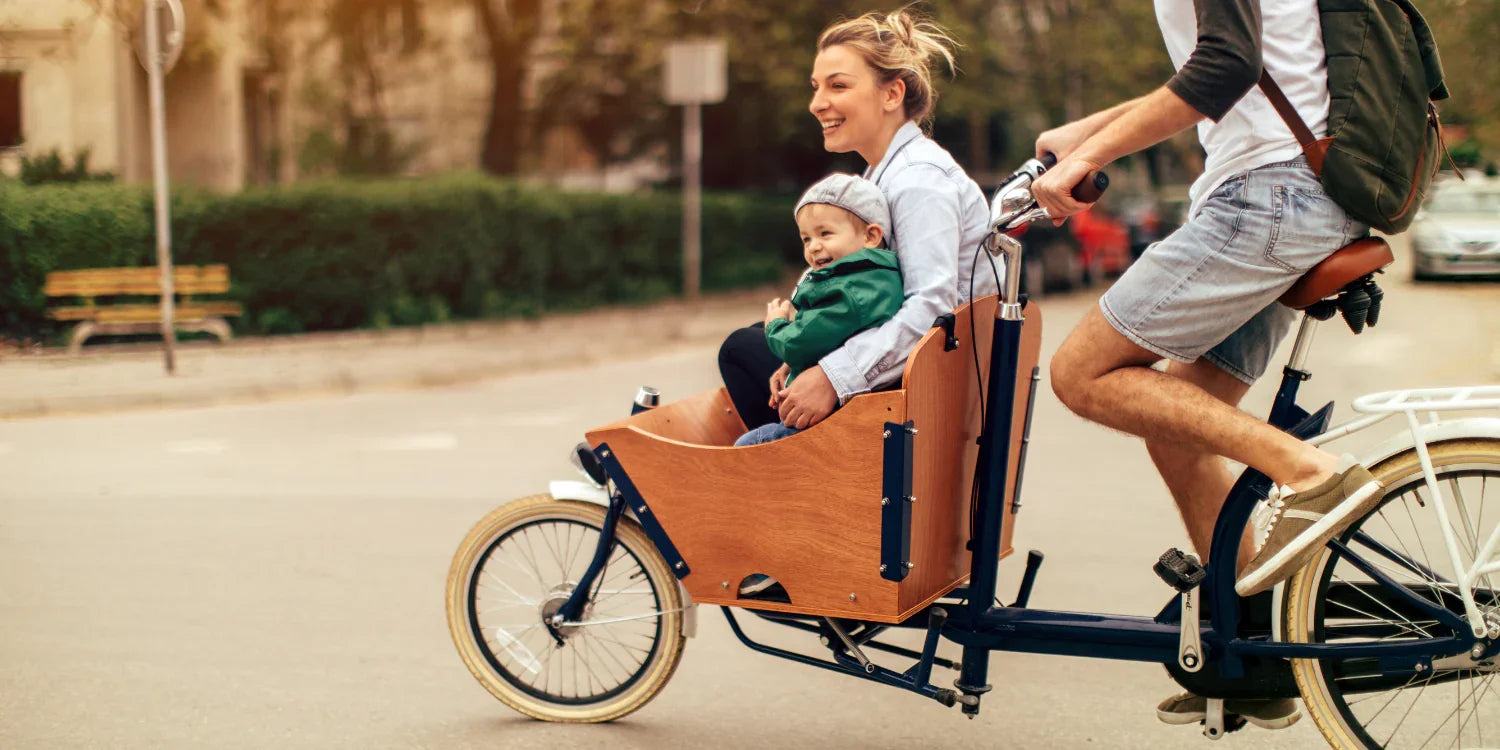UK Cargo Bikes: A Sustainable Way

In recent years, cargo bikes have become a common sight in UK cities. These bikes are designed to carry everything from groceries to freight. They offer a practical alternative to cars and vans. Families appreciate them for school runs and shopping trips, while businesses use them to move goods efficiently.
Understanding UK Cargo Bike Regulations
Before purchasing or riding a cargo bike, it’s important to know the legal framework:
-
EAPC classification
In the UK, most electric cargo bikes are classified as Electrically Assisted Pedal Cycles (EAPCs). An EAPC must have pedals, an electric motor with a continuous rated power not exceeding 250 watts, and assistance that cuts out above 15.5 mph Bikes that meet these criteria are treated as bicycles under the law. Read More here.
-
No licence or registration
You do not need a driving licence to ride an EAPC, and it does not require vehicle registration or road tax. Riders must be at least 14 years old.
-
Markings and safety
An EAPC must display the motor’s power and manufacturer, and show either the battery voltage or the bike’s maximum speed.
-
Where you can ride
Electric cargo bikes can use the same cycle paths and lanes as pedal bikes.
Read More on Riding E-Bike Rules
Proposed Legislation Changes and Outcome
In 2024, the government consulted on proposals to double the power limit for EAPCs to 500 watts and allow throttle assistance up to 15.5 mph. The aim was to make electric bikes and cargo bikes more accessible and better suited for hilly terrain. However, after receiving feedback from stakeholders, the government decided in January 2025 not to proceed with these changes because of safety concerns and a lack of supporting evidence. The existing 250‑watt power limit and pedal‑assist rules therefore, remain in place.

Main Types of Cargo Bikes
Cargo bikes come in several configurations, each with distinct advantages:
-
Box bikes (bakfiets)
These have a large box or platform at the front, positioned low to keep the centre of gravity stable. They are ideal for carrying children or medium‑sized loads while keeping cargo visible to the rider. Some models have two wheels; others use three for added stability.
-
Longtail bikes
Resembling standard bicycles with extended rear racks, longtails offer extra carrying capacity without being excessively bulky. Their narrower footprint makes them easier to manoeuvre and store in urban environments. Accessories such as child seats, panniers, and cargo boxes can be attached to customise the carrying space.
-
Tricycle cargo bikes
These three‑wheelers provide maximum stability and can carry heavier loads. Because they stand upright on their own, riders do not need to balance the bike at stops, making them suitable for beginners or anyone with balance concerns.
-
Conversion kits and accessories
If you already have a bicycle, conversion kits allow you to transform it into a cargo carrier. Kits typically include a frame extension or front box, wheels, and weatherproof fabric. This approach saves space and reduces cost while increasing versatility.

Choosing the Right Cargo Bike
Selecting the best cargo bike depends on several factors:
-
Riding ability
Longtail bikes handle much like conventional bicycles, so they are easier for new riders. Box bikes and tricycles may require more practice due to their larger size or different steering mechanisms.
-
Cargo requirements
Determine what you need to transport. For parcels or tools, look for a bike with a secure box or modular rack. Food deliveries require insulated and weatherproof storage. Always choose water‑resistant materials to protect goods in the UK’s wet climate.
-
Urban environment
Consider the streets you’ll be riding on. Compact longtail bikes are well‑suited to narrow city lanes, while tricycles are better for open or designated cycle tracks. Be aware that cargo bikes are longer and wider than standard bikes, so parking and storage should be planned ahead.

Cargo Bikes for Business and Professional Use
For companies making deliveries or transporting equipment, cargo bikes offer significant advantages. Electric models combine human power with pedal assistance, enabling riders to move heavy loads without emitting emissions. Government support for e‑cargo bikes through grants and local authority funding highlights their role in reducing congestion and improving air quality.
Professional cargo bikes often include:
-
Large, lockable cargo boxes
Many longtail and tricycle models come with front and rear boxes that can hold hundreds of litres, keeping goods secure and organised.
-
Electric assistance
Powerful motors (within the legal 250‑watt limit) help riders carry heavy freight over longer distances without fatigue.
-
Safety features
Integrated lights, reflective strips, and weatherproof fabric ensure the bike is visible and the cargo protected.
Models like the U‑Cargo Pro (a longtail example) illustrate how manufacturers tailor bikes for business: easy handling, substantial carrying capacity, and options for custom branding.

Conclusion
The rise of cargo bikes in the UK demonstrates a shift towards cleaner, more efficient urban transportation. With clear regulations, a thriving marketplace of bike styles, and growing government support, cargo bikes are becoming integral to both family life and commercial logistics. Staying informed about current laws, such as power limits and age restrictions. Ensures you choose the right bike and ride safely. Whether you’re looking to replace car trips or streamline your business deliveries, cargo bikes offer a flexible and sustainable solution.
Need Advise? Contact US

 30 DAY MONEY BACK GUARANTEE. NO QUIBBLE!
30 DAY MONEY BACK GUARANTEE. NO QUIBBLE! FREE MAINLAND UK SHIPPING ON ORDERS ABOVE £49
FREE MAINLAND UK SHIPPING ON ORDERS ABOVE £49 FRIENDLY CUSTOMER SUPPORT
FRIENDLY CUSTOMER SUPPORT  SAFE & SECURE PAYMENTS. ALL MAJOR CARDS
SAFE & SECURE PAYMENTS. ALL MAJOR CARDS